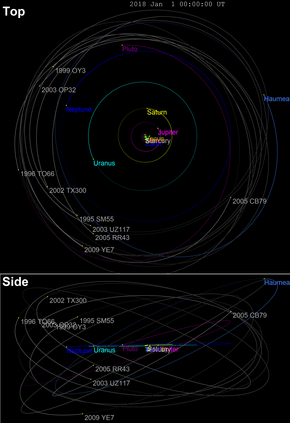 (120178) 2003 OP32 among other Haumea family objects | |
| Discovery | |
|---|---|
| Discovered by | M. E. Brown, C. Trujillo, D. Rabinowitz[1] |
| Discovery date | 26 July 2003 |
| Designations | |
| (120178) 2003 OP32 | |
| Cubewano (MPC)[2] Extended (DES)[3] | |
| Orbital characteristics[4] | |
| Epoch 13 January 2016 (JD 2457400.5) | |
| Uncertainty parameter 3 | |
| Observation arc | 9205 days (25.20 yr) |
| Aphelion | 47.620 AU (7.1239 Tm) |
| Perihelion | 38.480 AU (5.7565 Tm) |
| 43.050 AU (6.4402 Tm) | |
| Eccentricity | 0.10615 |
| 282.47 yr (103172 d) | |
Average orbital speed | 4.51 km/s |
| 71.841° | |
| 0° 0m 12.561s / day | |
| Inclination | 27.219° |
| 182.930° | |
| 67.082° | |
| Jupiter MOID | 33.5815 AU (5.02372 Tm) |
| TJupiter | 5.208 |
| Physical characteristics | |
| Dimensions | 230 km[5][6] |
| 9.71 h (0.405 d) | |
| 8.45 h[7] | |
| 0.7 (assumed) | |
| Temperature | ~42 K |
| (Neutral) B−V=0.70, V-R=0.39[8] B0-V0=0.698[7] | |
| 3.8[4] | |
(120178) 2003 OP32, also written as (120178) 2003 OP32, is a trans-Neptunian object (TNO) that resides in the Kuiper belt. It was discovered on July 26, 2003 by Michael E. Brown, Chad Trujillo and David L. Rabinowitz at Palomar Mountain in California.
- ^ List Of Transneptunian Objects Archived 2007-06-19 at the Wayback Machine
- ^ "MPEC 2009-R09 :Distant Minor Planets (2009 SEPT. 16.0 TT)". IAU Minor Planet Center. 2009-09-04. Retrieved 2009-10-04.
- ^ Marc W. Buie (2005-09-03). "Orbit Fit and Astrometric record for 120178". (using 41 of 42 observations) SwRI (Space Science Department). Retrieved 2009-10-04.
- ^ a b "JPL Small-Body Database Browser: 120178 (2003 OP32)". (last obs). 2009-07-19. Archived from the original on 2020-08-19. Retrieved 11 April 2016.
- ^ Assuming a Haumea-like albedo of 0.7
- ^ Dan Bruton. "Conversion of Absolute Magnitude to Diameter for Minor Planets". Department of Physics & Astronomy (Stephen F. Austin State University). Retrieved 2009-12-27.
- ^ a b David L. Rabinowitz; Bradley E. Schaefer; Martha W. Schaefer; Suzanne W. Tourtellotte (2008). "The Youthful Appearance of the 2003 EL61 Collisional Family". The Astronomical Journal. 136 (4): 1502–1509. arXiv:0804.2864. Bibcode:2008AJ....136.1502R. doi:10.1088/0004-6256/136/4/1502. S2CID 117167835.
- ^ Snodgrass, Carry; Dumas, Hainaut (16 December 2009). "Characterisation of candidate members of (136108) Haumea's family". Astronomy and Astrophysics. 511: A72. arXiv:0912.3171. Bibcode:2010A&A...511A..72S. doi:10.1051/0004-6361/200913031. S2CID 62880843.